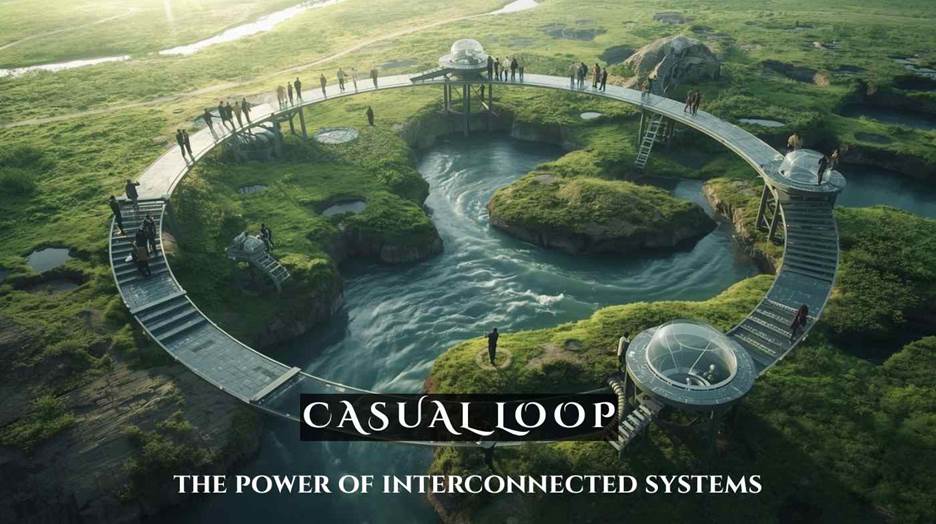A causal loop is one of the most fascinating concepts used in system dynamics, time travel theories, and even philosophical debates. At its core, it describes a circular chain of cause-and-effect relationships where an action feeds back into itself, creating continuous cycles of influence. This idea sparks curiosity because it challenges our linear way of thinking about events and outcomes.
Table of Contents
In this article, we will explore the definition and history of the causal loop, why it is important, its benefits and challenges, and how it appears in real-world systems. From scientific modeling to everyday decision-making, understanding causal loops helps us see the bigger picture and make smarter choices. Whether you are a student, researcher, or simply curious about how patterns shape the world, this guide will provide a clear and engaging look into the power of causal loops.
Causal Loop Definition and Core Concept
A causal loop refers to a sequence where an event influences another, and eventually, the outcome feeds back into the original cause. These loops can be reinforcing, where they amplify growth, or balancing, where they regulate stability. For example, population growth creates more births, which further increases population a reinforcing loop. On the other hand, body temperature regulation is a balancing loop that keeps conditions stable.
By breaking down processes into loops, we can better understand why systems behave the way they do. Economists, scientists, and engineers often use causal loop diagrams to visualize these relationships and predict outcomes more accurately.
Causal Loop Background and Historical Significance
The idea of a causal loop is not new. It has roots in philosophy, physics, and systems thinking. In ancient philosophy, thinkers often questioned whether events were predetermined or shaped by repeating cycles. Later, cybernetics and system dynamics in the 20th century formalized causal loop analysis.
The concept became especially popular through Jay W. Forrester’s system dynamics models in the 1960s. These models allowed experts to map feedback loops in business, economics, and ecology. Over time, the term also gained popularity in science fiction, where time travel paradoxes often rely on causal loops, such as a future event causing a past action that in turn makes the future possible.

Importance of Causal Loop in System Dynamics
Understanding a causal loop is crucial because it shows how small actions can ripple through entire systems. In business, a marketing campaign may increase customer satisfaction, which boosts brand reputation, attracting more customers and generating even stronger campaigns. In climate science, rising temperatures melt ice, which reduces reflection of sunlight, leading to even higher temperatures.
Without recognizing these loops, decision-makers risk focusing only on short-term effects instead of long-term consequences. Causal loop thinking trains people to anticipate unintended outcomes, manage risks, and design sustainable strategies.
Benefits of Applying Causal Loop Thinking
Studying and applying causal loop analysis brings several benefits:
•Improved decision-making by identifying hidden feedback effects
•Enhanced problem-solving through holistic perspectives
•Increased accuracy in predicting system behavior
•Support for sustainable planning in business, health, and environment
•Greater awareness of reinforcing and balancing forces within any situation
These benefits make causal loop analysis a powerful tool not just for academics but also for leaders, policymakers, and innovators.
Challenges and Limitations of Causal Loop Models
Despite their usefulness, causal loop models come with challenges:
•Complexity: Real systems often involve countless variables that are hard to map
•Oversimplification: Diagrams may miss critical connections
•Uncertainty: Predictions depend on assumptions that may not always hold true
•Misinterpretation: Without proper training, loops can be misunderstood
Recognizing these limitations ensures that causal loop diagrams are used as guides rather than absolute truths. They should complement, not replace, critical thinking and evidence-based strategies.

Real-World Examples of Causal Loop in Action
Causal Loop in Climate Change
Global warming offers one of the clearest examples of a causal loop. As carbon emissions rise, global temperatures increase, which melts polar ice. This reduces the Earth’s albedo (reflectivity), causing even more heat absorption and accelerating warming. This reinforcing loop highlights the urgency of climate action.
Causal Loop in Business Growth
In a company, high employee motivation leads to better productivity. Better productivity drives profit, which allows for rewards and incentives. These incentives motivate employees even more, forming a reinforcing loop that supports business success.
Causal Loop in Human Health
In healthcare, physical activity boosts energy and improves mood. A better mood encourages more activity, creating a positive feedback cycle. On the other hand, poor diet may reduce energy, leading to less exercise and worsening health a balancing loop in reverse.
Why Causal Loop Thinking Matters Today
In today’s interconnected world, problems are rarely isolated. Whether dealing with global crises, corporate challenges, or personal goals, understanding the causal loop helps reveal underlying patterns that traditional analysis might miss. It encourages systems thinking, where relationships matter as much as individual events.
From predicting economic recessions to designing effective public policies, causal loop analysis provides tools for navigating complexity. It bridges science, philosophy, and real-life practice, making it one of the most versatile frameworks for modern problem-solving.
Conclusion
A causal loop is more than just a theoretical concept it is a lens for understanding how systems truly work. By identifying reinforcing and balancing loops, individuals and organizations can anticipate long-term outcomes, avoid unintended consequences, and design better solutions. While challenges exist in applying causal loop models, the benefits of improved decision-making and deeper insights far outweigh the risks. As we face increasingly complex global challenges, exploring causal loops equips us with the clarity to act wisely and sustainably. Keep learning, stay curious, and embrace the power of systems thinking.